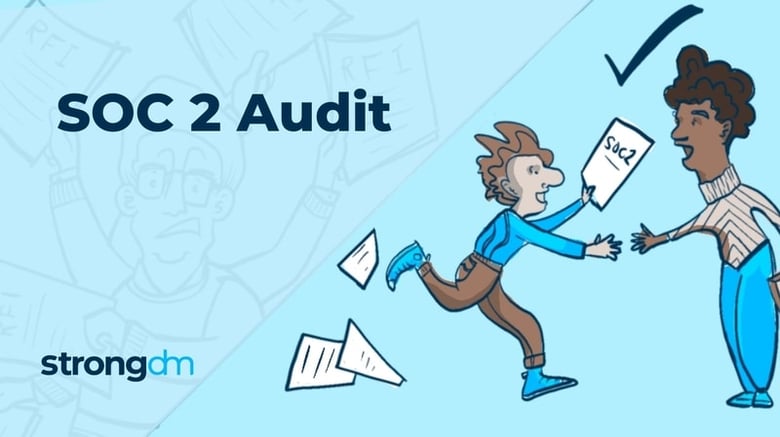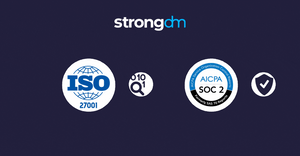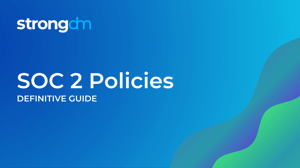
- Role-based, attribute-based, & just-in-time access to infrastructure
- Connect any person or service to any infrastructure, anywhere
- Logging like you've never seen

Summary: In this article, we’ll review everything you need to know about SOC 2 audits, including what they are, why you need them, and what you’ll need to do to complete one. By the end of this article, you will have a clear understanding of what the SOC 2 audit process looks like, who is involved, how much it will cost, and how long it will take.
What Is a SOC 2 Audit?
A SOC 2 audit assesses a service organization’s internal controls governing its services and data. These controls are called the Trust Services Principles and include security, availability, processing integrity, confidentiality, and privacy as outlined by the American Institute of Certified Public Accountants (AICPA).
SOC 2 is a framework designed to help companies (typically software vendors) demonstrate the security controls they use to protect customer data in the cloud. And a SOC 2 compliance audit confirms an organization is adhering to best practices when securing sensitive internal and customer data.
Note: SOC 2 audits center around the Trust Services Principles mentioned above. However, not all five principles will apply to every organization. For example, if you store data containing personal information, the privacy principle applies. If you have a data center and offer storage as a service to customers, the security and availability principle applies. Because every organization has a unique set of controls, SOC 2 audits are unique to each company.
Types of SOC 2 audits
There are two types of SOC 2 reports:
SOC 2 Type 1- Examines security controls at a specific point in time.
SOC 2 Type 2- Assesses those same controls over a longer period of time (typically 6 to 12 months).
Type 1 reports are easier and more affordable to complete as they only assess a snapshot in time.
Type 2 reports are broader in scope and therefore costlier in terms of time, money, and resources. Type 2 reports go deeper to provide a more comprehensive audit by assessing a company’s security controls over time.
Both reports are useful for demonstrating a robust security posture and give the service provider a competitive advantage compared to organizations that do not invest in SOC 2 audits.
🎉 Have you heard? StrongDMoffers a free and completely self-paced online SOC 2 Course.
What Are the Benefits of Completing a SOC 2 Audit?
SOC 2 compliance isn’t mandated by law or any industry regulations. However, that doesn’t mean they aren’t valuable. SOC 2 audits play an essential role in regulatory oversight, internal governance, and risk management—and they have become a minimum standard for organizations evaluating their cloud service vendors.
Customer confidence
As cyber risks grow, businesses only want to work with organizations they trust. As a result, companies that show SOC 2 compliance are more likely to close more deals.
SOC 2 audit reports ensure organizations are handling customer data securely, which is increasingly important as cyber risk tops business priorities in 2022. Demonstrating SOC 2 compliance reassures customers and increases their confidence in your services.
Cost savings
Despite the high upfront investment of a SOC 2 audit (totaling around $147,000 for a six-month report), SOC 2 internal audits can save you much more in the long run. In 2021, the average cost of a data breach was over $4 million—and the costs keep rising.
But, SOC 2 audits reveal an organization’s strengths and weaknesses, helping companies mitigate their risks while enhancing their security and compliance postures. In other words, in addition to helping you prevent security breaches and data loss, SOC 2 audits can also save you money over the long term.
Security insights
SOC 2 audits aren’t just nice reports to file away. They provide valuable insights into your company’s security posture, internal controls, governance, and regulatory oversight, which you can use to further mitigate risks, improve systems, and improve compliance readiness.
What Does the SOC 2 Audit Process Look Like?
The SOC 2 audit process can be divided into two stages: preparation and execution.
Preparing for the audit
Before you hire a CPA to conduct an audit, you’ll need to take a few steps to prepare.
Define Your Audit’s Scope and Objectives
Confirm what the user entity wants to learn from the audit and what controls will be included within that scope. If you aren’t sure which Trust Services Principles apply, you can work with your auditor to figure it out. Once you have a clear scope in mind, your team can get to work documenting policies.
Document Policies and Procedures
SOC 2 Type 2 audits require thorough documentation of information security policies based on the Trust Services Principles. These are what the auditor will assess your controls against, so it’s important they are clear and comprehensive. Depending on how many principles and controls apply to you, this step can take some time. Make sure you have a large enough team to help.
Perform a Readiness Assessment
With your policies outlined and documented for the auditor, you can perform a gap analysis or readiness assessment to determine your preparedness for the SOC 2 audit. This exercise is essentially your practice round before the official audit. It’s your chance to evaluate your policies and practices and identify any weaknesses or risks within your framework.
Completing the audit
When you’re ready for your audit, your CPA will work through the following SOC 2 audit checklist:
- Review the audit scope: Before starting, they will sit down with you to look over the scope and make sure it’s clear.
- Develop a project plan: With the scope in mind, the auditor will create a plan and share an expected project timeline.
- Test security controls: Then, the auditor will dive in and begin testing your controls for design and/or operational effectiveness.
- Document the results: They will record the results.
- Deliver the client report: The auditor will provide a written evaluation of your controls and share a final opinion on whether the organization is suitably designed to ensure data security.
Who Performs a SOC 2 Audit?
SOC 2 audits are regulated by the AICPA and must be completed by an external auditor from a licensed CPA firm in order to receive official certification. The CPA should specialize in information security and be completely independent of the organization they are auditing in order to ensure objectivity. CPA firms can employ a non-CPA consultant with relevant information security experience to assist in the audit preparation. However, the final report must be issued by a CPA.
Which staff members support a SOC 2 audit?
A SOC 2 audit is a substantial undertaking and won’t be limited to just your IT or security teams. As you prepare for your SOC 2 audit, start thinking about who needs to be involved in the process and what roles will need to be filled, such as:
- Executive sponsor
- Project manager
- Legal
- HR
- IT/Security
- External consultant
Learn more about the roles and responsibilities you’ll need to assign as you build your SOC 2 audit team.
How Long Does It Take to Complete a SOC 2 Audit?
Completing a SOC 2 security audit typically takes between six to 12 months. The schedule will usually include:
- Project kickoff and risk analysis
- Readiness assessment
- Remediation period
- Information requests
- Documentation
The exact timeline of the audit will depend on the scope and complexity of your organization.
Learn more about SOC 2 timelines in our post How Long Does It Take To Complete a SOC 2 Audit?
What Is Included in a SOC 2 Audit Report?
A SOC 2 audit report includes a written letter stating the auditor’s opinion. The opinion can fall into one of four categories:
Unqualified: The auditor completely supports the findings with no modifications.
Qualified: The issues the auditor found were minor enough that they didn’t merit a negative opinion.
Adverse: The auditor has concluded that the systems are not reliable.
Disclaimer: The auditor couldn’t issue an official opinion because they did not receive the necessary evidence required to determine an opinion.
In addition to the auditor’s opinion, the report may also include:
- A detailed description of the system or service.
- Details of the applicable trust services categories.
- Test results.
How Long Is a SOC 2 Audit Report Valid?
A SOC 2 audit report is valid for 12 months following the date the report was issued. Organizations should complete a SOC 2 audit annually to ensure continued compliance and robust security.
How Much Does a SOC 2 Audit Cost?
SOC 2 is a hefty investment—both in time, money, and resources. In addition to the audit itself, there are personnel costs, as well as tools and training costs that must be factored into the total investment. Altogether, the total cost of a 6-month SOC 2 audit can run up to $147,000.
For a full cost breakdown, see our article on what to expect in a SOC 2 Budget.
How Often Should You Do a SOC 2 Audit?
SOC 2 audits are an important part of your cybersecurity toolbelt. Keep customer, employee, and stakeholder data safe year-round by conducting annual security audits. When you are ready to complete SOC 2, check out Comply, a free SOC 2 compliance software by StrongDM.
About the Author
Brian Johnson, Security Engineer / Podcaster, is the president of 7 Minute Security, an information security consultancy in the Minneapolis area. Brian spends most of his days helping companies defend their networks.
Since 2004, Brian has also run the blog/podcast called 7 Minute Security, where he shares what he has learned about information security into short, 7-minute chunks.

You May Also Like





